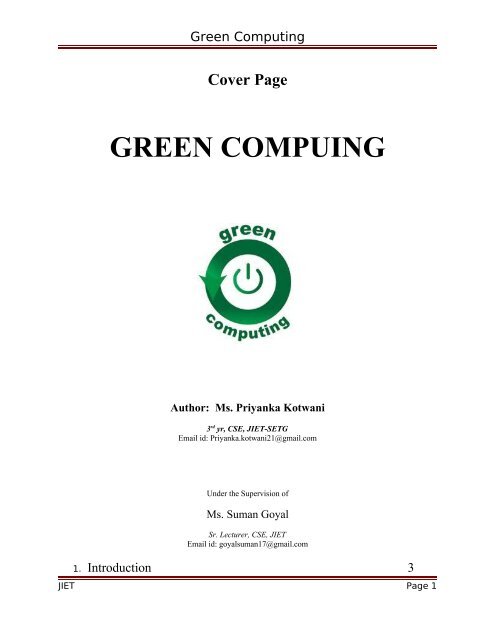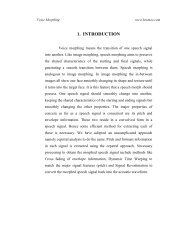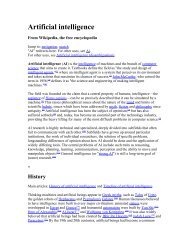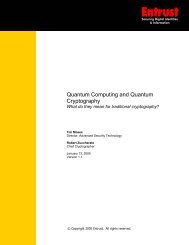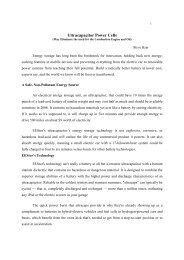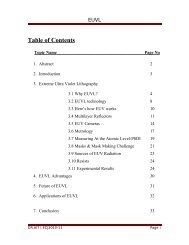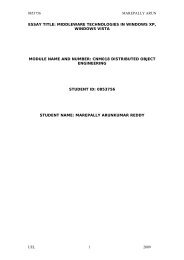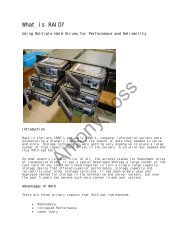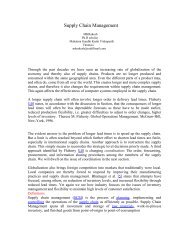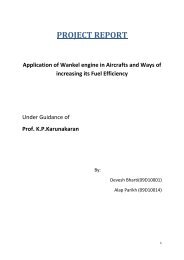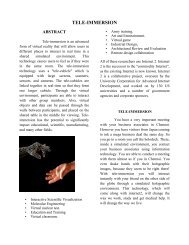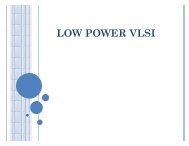Green Computing Seminar.pdf - 123SeminarsOnly
Green Computing Seminar.pdf - 123SeminarsOnly
Green Computing Seminar.pdf - 123SeminarsOnly
Create successful ePaper yourself
Turn your PDF publications into a flip-book with our unique Google optimized e-Paper software.
<strong>Green</strong> <strong>Computing</strong><br />
Cover Page<br />
GREEN COMPUING<br />
Author: Ms. Priyanka Kotwani<br />
3 rd yr, CSE, JIET-SETG<br />
Email id: Priyanka.kotwani21@gmail.com<br />
Under the Supervision of<br />
Ms. Suman Goyal<br />
Sr. Lecturer, CSE, JIET<br />
Email id: goyalsuman17@gmail.com<br />
1. Introduction 3<br />
JIET Page 1
<strong>Green</strong> <strong>Computing</strong><br />
2. Why <strong>Green</strong> <strong>Computing</strong> is Needed 3<br />
3. Core Objectives of <strong>Green</strong> <strong>Computing</strong> 4<br />
4. Approaches to <strong>Green</strong> <strong>Computing</strong><br />
4.1 Virtualization 4<br />
4.2 Power Management 5<br />
4.3 Power Supply 5<br />
4.4 Storage 5<br />
4.5 Display 6<br />
4.6 Materials Recycling 6<br />
4.7 Telecommuting 6<br />
5. N<strong>Computing</strong> - an architecture that changes the green equation<br />
5.1 Consumes 90% less energy per user 7<br />
5.2 Air conditioning—the hidden environmental cost 7<br />
5.3 98% less e-waste in landfills 8<br />
6. Future of <strong>Green</strong> <strong>Computing</strong> 8<br />
7. Conclusion 8<br />
8. Bibliography 9<br />
JIET Page 2
<strong>Green</strong> <strong>Computing</strong><br />
Abstract<br />
As 21st century belongs to computers, gizmos<br />
and electronic items, energy issues will get a<br />
serious ring in the coming days. If we think<br />
computers are nonpolluting and consume very<br />
little energy we need to think again. <strong>Green</strong><br />
computing is the term used to denote efficient<br />
use of resources in computing. This term<br />
generally relates to the use of computing<br />
resources in conjunction with minimizing<br />
environmental impact, maximizing economic<br />
viability and ensuring social duties. <strong>Green</strong><br />
computing is very much related to other similar<br />
movements like reducing the use of<br />
environmentally hazardous materials like CFCs,<br />
promoting the use of recyclable materials,<br />
minimizing use of non-biodegradable<br />
components, and encouraging use of sustainable<br />
resources. This seminar report gives a general<br />
overview on the current state of opportunities lie<br />
in green technology and organizations which are<br />
seeing it as a way to create new profit centers<br />
while trying to help the environmental cause<br />
and several formations that we can explore in it<br />
in coming future. The plan towards green IT<br />
should include new electronic products and<br />
services with optimum efficiency and all<br />
possible options towards energy savings.<br />
1. Introduction<br />
<strong>Green</strong> computing or green IT, refers to<br />
environmentally sustainable computing or IT.<br />
Dr. San Murugesan a Senior Consultant defines<br />
the field of green computing as "the study and<br />
practice of designing, manufacturing, using, and<br />
disposing of computers, servers, and associated<br />
subsystems—such as monitors, printers, storage<br />
devices, and networking and communications<br />
<strong>Green</strong> <strong>Computing</strong><br />
systems—efficiently and effectively with<br />
minimal or no impact on the environment."<br />
As 21st century belongs to computers, gizmos<br />
and electronic items, energy issues will get a<br />
serious ring in the coming days, as the public<br />
debate on carbon emissions, global warming<br />
and climate change gets hotter. The average PC<br />
wastes about half the energy provided to it,<br />
according to the Climate Savers <strong>Computing</strong><br />
Initiative, an industry group dedicated to<br />
reducing greenhouse-gas emissions<br />
The goals of green computing are similar<br />
to green chemistry; reduce the use of hazardous<br />
materials, maximize energy efficiency during<br />
the product's lifetime, and promote<br />
the recyclability or biodegradability of defunct<br />
products and factory waste. Research continues<br />
into key areas such as making the use of<br />
computers as energy-efficient as possible, and<br />
designing algorithms and systems for<br />
efficiency-related computer technologies.<br />
2. Why <strong>Green</strong> <strong>Computing</strong> is<br />
needed?<br />
IT Executives are at last coming under<br />
increasing pressure to deliver a <strong>Green</strong> IT or<br />
<strong>Green</strong> <strong>Computing</strong> Strategy. Executive boards<br />
are finally recognizing there can be a genuine<br />
competitive advantage in adopting green issues<br />
and signing up to a low carbon emissions<br />
footprint. Having a <strong>Green</strong> IT Strategy can<br />
directly affect the view of the organizations<br />
customers. Customers will clearly continue to<br />
evaluate suppliers based on product/service<br />
offerings and their costs, however, if all else is<br />
equal, then choosing a supplier with a low<br />
carbon policy can be a key differentiator. Most<br />
people do want to support green issues and<br />
adopting suppliers with low-carbon strategies<br />
helps buyers to feel good about their decisions.<br />
JIET Page 3
<strong>Green</strong> IT also brings with it direct cost benefits<br />
for the organization, making it an easier sell to<br />
the more sceptical boards of directors. With a<br />
<strong>Green</strong> <strong>Computing</strong> or IT Strategy we can reduce<br />
equipment, power, air-conditioning, and support<br />
costs. This applies throughout the enterprise<br />
not just in data-centers or our server rooms but<br />
desktop computers as well.<br />
3. Core Objectives of <strong>Green</strong><br />
<strong>Computing</strong> Strategies<br />
Minimizing energy consumption<br />
Purchasing green energy<br />
Reducing the paper and other<br />
consumables used<br />
Minimizing equipment disposal<br />
requirements<br />
Reducing travel requirements for<br />
employees/customers<br />
4. Approaches to <strong>Green</strong><br />
<strong>Computing</strong><br />
4.1 Virtualization:<br />
<strong>Green</strong> <strong>Computing</strong><br />
Computer virtualization is the process of<br />
running two or more logical computer systems<br />
on one set of physical hardware. With<br />
virtualization, a system administrator could<br />
combine several physical systems into virtual<br />
machines on one single, powerful system,<br />
thereby unplugging the original hardware and<br />
reducing power and cooling consumption. One<br />
of the primary goals of almost all forms of<br />
virtualization is making the most efficient use of<br />
available system resources.<br />
Virtualization highlights the idea of “<strong>Green</strong><br />
<strong>Computing</strong>”; by consolidating servers and<br />
maximizing CPU processing power on other<br />
servers. Storage virtualization makes it possible<br />
for systems to access a shared storage<br />
subsystem. It’s clear that this approach would<br />
reduce the number of storage devices needed,<br />
the amount of power required, the heat produced<br />
and, as a wonderful side effect, would reduce<br />
the operational and administrative costs of back<br />
up, archival storage etc.<br />
4.2 Power Management:<br />
Lower power consumption also means lower<br />
heat dissipation, which increases system<br />
JIET Page 4
stability, and less energy use, which saves<br />
money and reduces the impact on the<br />
environment.<br />
The Advanced Configuration and Power<br />
Interface (ACPI), an open industry standard,<br />
allows an operating system to directly control<br />
the power saving aspects of its underlying<br />
hardware. This allows a system to automatically<br />
turn off components such as monitors and hard<br />
drives after set periods of inactivity. In addition,<br />
a system may hibernate, where most<br />
components (including the CPU and the system<br />
RAM) are turned off. ACPI is a successor to an<br />
earlier Intel-Microsoft standard called Advanced<br />
Power Management, which allows a computer's<br />
BIOS to control power management functions.<br />
Power management for computer systems are<br />
desired for many reasons, particularly:<br />
Prolong battery life for portable and<br />
embedded systems.<br />
Reduce<br />
cooling requirements.<br />
Reduce<br />
noise.<br />
Reduce operating costs for energy and<br />
cooling.<br />
<br />
4.3 Power Supply:<br />
Power supplies in most computers (PSUs for<br />
short) aren't designed for energy efficiency. In<br />
fact, most computers drain more power than<br />
they need during normal operation, leading to<br />
higher electrical bills and a more dire<br />
environmental impact. The 80 Plus program is a<br />
voluntary certification system for power-supply<br />
manufacturers. If a PSU meets the certification,<br />
it will use only the power it needs at a given<br />
Load i.e. it won't use more power than it needs.<br />
Various initiatives are underway to improve the<br />
efficiency of computer power supplies.<br />
<strong>Green</strong> <strong>Computing</strong><br />
Climate savers computing initiative promotes<br />
energy saving and reduction of greenhouse gas<br />
emissions by encouraging development and use<br />
of more efficient power supplies<br />
4.4 Storage:<br />
There are three routes available, all of which<br />
vary in cost, performance, and Capacity.<br />
The most conventional route is the 3.5" desktop<br />
hard drive. For laying focus on reduced power<br />
consumption reduced RAM low power idle<br />
mode with fixed rotation speed have come in<br />
scene. Its advantage is highest possible capacity<br />
plus the best performance.<br />
The second option is to use a 2.5" laptop hard<br />
drive. These consume less power than larger<br />
disks as a result of their smaller platters, smaller<br />
motors, and firmware<br />
The lowest-power option is to use a solid state<br />
hard drive (SSD), which typically draw less than<br />
one-third the power of a 2.5" disk. The latest,<br />
highest-performance SSDs are very fast and<br />
consume less energy<br />
4.5 Displays:<br />
JIET Page 5
LCD monitors typically use a cold-cathode<br />
fluorescent bulb to provide light for the display.<br />
Some newer displays use an array of lightemitting<br />
diodes (LEDs) in place of the<br />
fluorescent bulb, which reduces the amount of<br />
electricity used by the display. LCD monitors<br />
uses three times less when active, and ten times<br />
less energy when in sleep mode. LCDs are up to<br />
66% more energy efficient than CRTs, LCDs<br />
are also upwards of 80% smaller in size and<br />
weight, leading to fuel savings in shipping.<br />
LCDs produce less heat, meaning you'll need<br />
less AC to keep cool.LCD screens are also<br />
easier on the eyes. Their lower intensity and<br />
steady light pattern result in less fatigue versus<br />
CRTs.<br />
4.6 Materials Recycling:<br />
Computer recycling refers to recycling or reuse<br />
of a computer or electronic waste<br />
Additionally, parts from outdated systems may<br />
be salvaged and recycled through certain retail<br />
outlets and municipal or private recycling<br />
centers. Recycling computing equipment can<br />
keep harmful materials such as lead, mercury,<br />
<strong>Green</strong> <strong>Computing</strong><br />
and hexavalent chromium out of landfills.<br />
<strong>Computing</strong> supplies, such as printer cartridges,<br />
paper, and batteries may be recycled as well.<br />
Obsolete computers are a valuable source for<br />
secondary raw materials, if treated properly,<br />
however if not treated properly they are a major<br />
source of toxins and carcinogens.<br />
4.7 Telecommuting:<br />
Teleconferencing and telepresence technologies<br />
are often implemented in green computing<br />
initiatives. The advantages are many; increased<br />
worker satisfaction, reduction of greenhouse gas<br />
emissions related to travel, and increased profit<br />
margins as a result of lower overhead costs for<br />
office space, heat, lighting, etc<br />
Rather than traveling great distances, in order to<br />
have a face-face meeting, it is now possible to<br />
teleconference instead, using a multiway video<br />
phone. Each member of the meeting, or each<br />
party, can see every other member on a screen<br />
or screens, and can talk to them as if they were<br />
in the same room. This brings enormous time<br />
and cost benefits, as well as a reduced impact on<br />
the environment by lessening the need for travel<br />
- a damaging source of carbon emissions.<br />
5. N<strong>Computing</strong> - an architecture<br />
that changes the green equation<br />
N<strong>Computing</strong> systems are a major leap forward<br />
in green computing. More than 15,000<br />
JIET Page 6
organizations in over 80 countries have used<br />
N<strong>Computing</strong> to slash their carbon footprint and<br />
electric consumption. The N<strong>Computing</strong> solution<br />
is based on a simple fact: today’s PCs are so<br />
powerful that the vast majority of applications<br />
only use a small fraction of the computer’s<br />
capacity. N<strong>Computing</strong>’s virtualization software<br />
and hardware tap this unused capacity so that it<br />
can be simultaneously shared by multiple users.<br />
The N<strong>Computing</strong> virtualization software works<br />
on a standard Windows or Linux1 PC. Each<br />
user’s monitor, keyboard, and mouse connect to<br />
the shared PC through a small and durable<br />
N<strong>Computing</strong> access device. The device itself<br />
has no CPU, memory, or moving parts—so it is<br />
easy to deploy and maintain. It also consumes<br />
very little power.<br />
5.1 Consumes 90% less energy per<br />
user<br />
PCs typically consume between 110 to 200<br />
watts of electricity. In contrast, N<strong>Computing</strong><br />
access devices consume next to nothing. In fact,<br />
N<strong>Computing</strong>’s L-series devices consume 5<br />
watts per added user and the X-series consume<br />
just 1 watt per added user. If you replace<br />
seventy PCs with ten PCs attached to sixty<br />
N<strong>Computing</strong> X-series access devices, you<br />
would save over 10,000 kilowatt-hours (kWh),<br />
<strong>Green</strong> <strong>Computing</strong><br />
which translates to over 1 metric ton of CO2<br />
emissions per year.<br />
5.2 Air conditioning—the hidden<br />
environmental cost<br />
A single PC generates more heat than a 100<br />
watt light bulb. A classroom, computer lab, or<br />
office with PCs warms up very<br />
quickly. In fact, PC-filled work areas almost<br />
always have to be air conditioned. Air<br />
conditioners raise electricity costs and require<br />
large capital expenditures to buy, install, and<br />
maintain them. In comparison, a room equipped<br />
with PCs and N<strong>Computing</strong> access devices<br />
generates 90% less heat and does not require<br />
additional air conditioning.<br />
5.3 98% less e-waste in landfills<br />
It is found out lately that while electronic waste<br />
represents only 2% of trash in landfills, it<br />
represents 80% of the toxic waste. N<strong>Computing</strong><br />
greatly reduces the magnitude of this problem.<br />
• In sheer weight, PCs generate much more<br />
waste than virtual desktops. A typical PC<br />
JIET Page 7
weighs about 21 pounds (9.5 kg); an<br />
N<strong>Computing</strong> access device weighs about 1/3 of<br />
a pound (0.15 kg), for a 98% reduction in<br />
electronic waste.<br />
• An N<strong>Computing</strong> access device also has a<br />
much longer useful life than a PC. When a<br />
shared PC is replaced with a newer one, the PC<br />
may go to a landfill, but the N<strong>Computing</strong> users<br />
can keep their access devices and enjoy the<br />
boost in performance from the new PC. So<br />
whereas PCs might be upgraded every three<br />
years or so, access devices could easily last five<br />
years or more. With less frequent turnover, less<br />
equipment ends up in landfills.<br />
• N<strong>Computing</strong> access devices are also compliant<br />
with RoHS regulations, which restrict the use of<br />
lead and other harmful metals.<br />
6. Future of <strong>Green</strong> <strong>Computing</strong><br />
The plan towards green IT should include new<br />
electronic products and services with<br />
optimum efficiency and all possible<br />
options towards energy savings. That is<br />
enterprise wise companies are laying<br />
emphasis on moving towards Eco<br />
Friendly Components in Computers, the<br />
use of eco-friendly sustainable<br />
components will become the norm<br />
rather than the exception in future.<br />
To this approach for an instance - A Canadian<br />
Company, Userful Inc. (www.userful.com) have<br />
come up with a solution that turns 1 computer<br />
into 10 - Discover Station. Quickly becoming<br />
the standard for green computing worldwide,<br />
Discover Station leverages the unused<br />
computing power of modern PC’s to create an<br />
environmentally efficient alternative to<br />
traditional desktop computing. Multiple users<br />
can work on a single computer by simply<br />
<strong>Green</strong> <strong>Computing</strong><br />
attaching up to 10 monitors, mice and<br />
keyboards. This makes it possible to reduce<br />
CO2 emissions by up to 15 tons per year per<br />
system and reduce electronic waste by up to<br />
80%. Userful has recently stated that in the last<br />
year their software has saved over 13,250* tons<br />
of CO2 emissions, the equivalent of taking<br />
2,300 cars off the road.<br />
Another approach for future <strong>Green</strong> <strong>Computing</strong><br />
is building big more and more data centers<br />
where data center refers to a centralized<br />
repository, either physical or virtual, for the<br />
storage, management, and dissemination of data<br />
and information organized around a particular<br />
body of knowledge or pertaining to a particular<br />
business.<br />
7. Conclusion<br />
So far, consumers haven't cared about<br />
ecological impact when buying computers,<br />
they've cared only about speed and price. But as<br />
Moore's Law marches on and computers<br />
commoditize, consumers will become pickier<br />
about being green. Devices use less and less<br />
power while renewable energy gets more and<br />
more portable and effective. New green<br />
materials are developed every year, and many<br />
toxic ones are already being replaced by them.<br />
So green computing is a<br />
mindset that asks how we can satisfy the<br />
growing demand for network computing<br />
without putting such pressure on the<br />
environment. There is an alternative way to<br />
design a processor and a system such that we<br />
don't increase demands on the environment, but<br />
still provide an increased amount of processing<br />
capability to customers to satisfy their business<br />
needs. <strong>Green</strong> computing is not about going out<br />
and designing biodegradable packaging for<br />
products. Now the time came to think about the<br />
efficiently use of computers and the resources<br />
JIET Page 8
which are non renewable. It opens a new<br />
window for the new entrepreneur for harvesting<br />
with E-waste material and scrap computers.<br />
The greenest computer will not<br />
miraculously fall from the sky one day; it’ll be<br />
the product of years of improvements. The<br />
features of a green computer of tomorrow<br />
would be like: efficiency, manufacturing &<br />
materials, recyclability, service model, selfpowering,<br />
and other trends. <strong>Green</strong> computer will<br />
be one of the major contributions which will<br />
break down the 'digital divide', the electronic<br />
gulf that separates the information rich from the<br />
information poor.<br />
8. Bibliography<br />
file:///D:/15%20sept%20ppt/<strong>Green</strong><br />
%20computing%20-%20Wikipedia,<br />
%20the%20free%20encyclopedia.htm<br />
www.research.microsoft.com/pubs/7881<br />
3/AJ18_EN.<strong>pdf</strong><br />
www.technopreneur.net/information.../<br />
<strong>Green</strong><br />
%20<strong>Computing</strong>.<strong>pdf</strong><br />
www. computeruser.com/.../the<br />
futureof-green-<br />
computing.html<br />
www.pcmicronetics.com/.../ NComputin<br />
g %20Technology%20White%20Paper<br />
%202-2-07. <strong>pdf</strong><br />
www.en.wikipedia.org/wiki/ Data_<br />
center<br />
www.brighthub.com/environment/ green-<br />
computing/.../73844.aspx<br />
<strong>Green</strong> <strong>Computing</strong><br />
JIET Page 9
<strong>Green</strong> <strong>Computing</strong><br />
JIET Page 10


